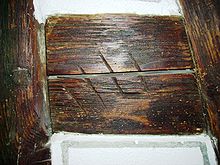Joinery mark
Joining signs , also called bundle signs , are letters, numbers, symbols and patterns used by the carpenters , which are used to quickly and reliably assign and assemble the components in a composite (or association ) for trusses , roof trusses and roofing and other technical trusses .
As Abbund is the process in which the fabric made of wooden framework construction and with the appropriate timber joints is assembled. With traditional joinery , the components are processed by the carpenters on the drawing floor at the joinery station , sawed to size and put together on a trial basis. The components that belong together are provided with a simple graphic symbol, the joining symbol, so that correct and quick assembly is possible during the final assembly. The symbols are located on the flange side , on which the components of different thicknesses are usually in alignment .
The characters can be documented in a cadastral register. This system can also be used to reassemble a dismantled roof or half-timbered house in another location. In building research , this is used to check whether the framework or roof structure has already been changed in historical times.
The joinery marks are hammered in either with the ax or the chisel . Marking with the tear hook is also possible. Marking with pencil or colored pencil is possible for short-term marking.
Depending on the construction, different methods are common and follow different customs locally and depending on the workshop.
In the case of roof trusses, frame constructions and similar constructions, all timbers are given a symbol for each timber connection, for example each chair frame or wall is marked with a mark - the arrangement of the timbers in relation to one another within a construction unit results from the shape.
In the block construction , the main front is seen from the left. The associated marking depends on the location: Long walls, cross walls and the floors have their symbols. Long walls get rods , a diagonal line. Cross walls have stitches on the number sign. The first floor is given a triangle , also known as a high . There are two triangles on the second floor and an additional symbol for each additional floor. Posts and struts, but also headbands, have their corresponding symbols below. Sleepers, purlins , tongs and frames on the left.
The woods are listed using Roman numerals. A special feature is that the number 4 is often not marked as “IV” but as “IIII” in order to avoid confusion. Likewise, the number 9 is represented as "VIIII". In addition to these signs, the wall sign, section sign, the collar sign and the marking for an invalid crack are also in use.
literature
- Johannes Cramer : covenant mark. In: Building with wood. 3/1986, pp. 136-140
- Johannes Cramer: Bundzeichen - a symbol of prefabrication. In: Fritz Scheidegger: From the history of construction technology. Basel, No. 2/1992, pp. 28-36
- Wilhelm Friedrich: Book of tables for the building and wood industry. Edition B, Fachbuchverlag GmbH Leipzig, 1951
- G. Fritsche: Marking and joining technique. In: The carpentry. Giessen, 1954, pp. 365-406
- Manfred Gerner: Handcrafted wood connections by the carpenters. Deutsche Verlags-Anstalt DVA 1992, ISBN 3-421-03027-8
- Burghard Lohrum: Contributions to southwest German house research. Medieval joinery signs on the half-timbered house Hintere Gasse 39 in Sindelfingen. In: Sindelfingen yearbook. 22 / III, pp. 367-406
- Horst Masuch: Working method and results of historical building research - joinery signs and roof structures. In: Lower Saxony Monument Preservation. Hanover, No. 11/1985, pp. 70-80r


